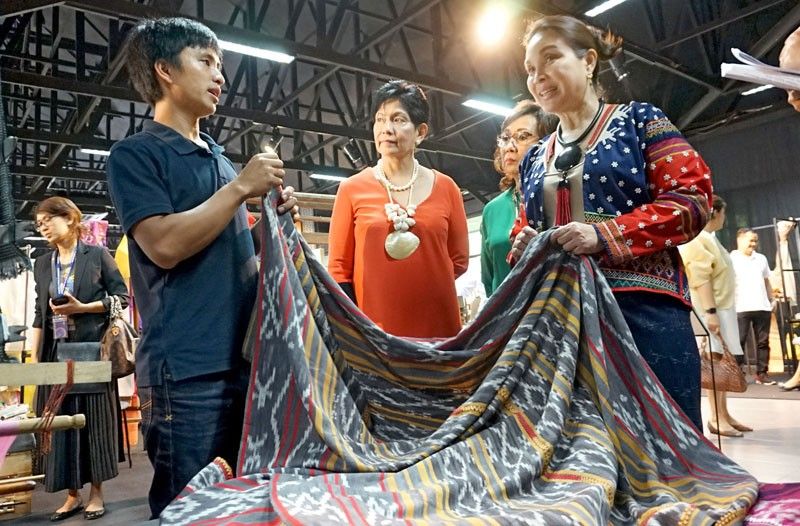Senator Loren Legarda on weaver Sammy Buhle: ‘He brought soul to the looms.’

Some things are threaded in the looms of coincidences.
In one of her trips to the Cordilleras, Senator Loren Legarda chanced upon a small, home-based weaving center in Ifugao run by Sammy Buhle and his mother, Angelina. The mother-and-son tandem specializes in Ikat weaving.
The senator watched in amazement. “I saw intently the transformation of natural fiber into strips of Ikat threads,” she recalls. “I was in awe at the distinct beauty of their weaves, astounded by the intricate, elegant technique of their weaving. I can vividly recall how, at that time, I instantly imagined myself wearing this kind of exquisite material to international events. It is uniquely Filipino, homegrown, and made with so much passion.”
Later on, she learned that the weaving center was going through a rough patch; a government agency was trying to confiscate the Buhles’ dyeing vats.
“Yun ’yung pinaglulutuan ng mga tela,” Sammy points out how important those vats are. “Nung ’yung father ko pa may hawak ng weaving center namin, nag-loan siya dun sa government agency. Hindi sila nakapag-bayad, so mafo-foreclose na dapat ’yung loan. Nabanggit ko kay Senator Legarda ’yung problema namin. Agad siyang um-action.”
Senator Legarda made sure that the matter was taken care of and that the Buhles could focus on weaving. She also assisted Sammy in going to Manila to do weaving demonstrations at the National Museum and the ASEAN Summit in 2017.
“I believe in Sammy’s ability and trust his world-class Ikat weaves. When I think of the Cordilleras, I think of its authentic beauty. It echoes the skill and creativity of the people who live there. Sammy Buhle is a national treasure and an icon of his home province of Ifugao. He takes great pride in his identity and has already proven himself at a very young age. His focus is not only to generate income and support their livelihood but also to sustain their cultural heritage and continue the legacy passed to them by their forebears.”
She was pleasantly surprised when the winning proposal for the 59th Venice Biennale curated by Yael Buencamino-Borromeo and Arvin Flores featured the collaboration among artist Gerry Tan, ethnomusicologist Felicidad Prudente, and weaver Sammy Buhle.
The senator characterizes it as the weaves journeying from the mountains of Ifugao to the canals of Venice. What a long, sagely trip it had been.
“Sammy was able to present his talent and unique ideas to the world. ?ÒÒÒI believe that it is important for propagators of indigenous cultures like Sammy to be part of contemporary conversations. After all, our indigenous peoples have undergone, and continue to face life-changing problems such as eviction from their ancestral lands, the destruction of the natural environment that they protected, loss of resources, poverty, marginalization, militarization, and many more. I feel gratified that his work has been elevated to a global stage and was well-received.”
The weaver who astounds with his Ikat weaves — yet oh-so-humble, soft-spoken, and always thinking about his family back home — was able to present his creations at the art world’s most prestigious platform, the Venice Art Biennale.
“The concept of the Philippine Pavilion was successfully communicated because the exhibit itself connected to people as it ‘spoke’ in various languages. It created a discourse that echoed to the world that was able to hear the depths of the Filipino creative spirit through the art of conveying sound, combined with recordings of indigenous weaving practices across the country. Everyone witnessed the underlying story of weaving as a Filipino tradition and saw contemporary resonance through the prestigious Biennale Arte in Venice, Italy. It revealed the Filipino people’s creative prowess, emotional depth, and willingness to take risks while expressing themselves artistically. This truly made me proud.”
?ÓÓÓÓShe believes that there are more Sammy Buhles in different parts of the country who wish to share their artistry and traditions to the world. “For so long, these Filipinos have preserved their way of life, values, knowledge, skills, and traditions—the importance of which we are only discovering now as we try to keep our sense of identity amidst a fast-changing world.”
Do not fret, folks. The senator is doing everything in her power.
She is responsible for the MSME (Micro, Small and Medium Enterprise) Law, a platform for the promotion and expansion of viable rural livelihoods, such as weaving, while supporting environmental cultural preservation, employment generation, and economic empowerment of indigenous peoples, such as the Buhles. She principally authored the Philippine Tropical Fabrics Law, or Republic Act No. 9242, which mandates that all official government uniforms in the Philippines be made from locally-sourced and locally-made textiles. Already she has filed Senate Bill No. 241, or the Philippine Handloom Weaving Industry Development Act, to support the handloom weaving industry and to empower local people and artisans to bring their traditional crafts into the mainstream textile sector. The senator hopes to accomplish more in the coming years.
She amplifies, “I have so much admiration for Philippine weavers, and my stand is firm on giving the Philippine weaving industry a fighting chance not only here in the country but on an international scale. Handloom weaving, for example, is one of the country’s most time-honored industries. Its practice is a never-ending narration of our history and heritage. It is the past talking to us through the talent and passion of our weavers. It deserves to be sustained and promoted, and thus our weavers need our support to sustain this noble craft.”
Local entrepreneurs and indigenous communities are always on the radar of the lawmaker from Antique. The same with artists and cultural workers.
Last July, Senate President Pro Tempore Loren Legarda filed Senate Bill No. 492, which pushes for the institutionalization of the Philippine participation in the international exhibitions of the Venice Biennale.
“The field of the arts has a way of reawakening the national identity,” she concludes. “They too have a critical role in communicating who we are as a nation, fostering national growth and development, and forging a unique connection to the world. The Filipinos still have more to share, and the world has more to learn about us.”
She is right. We Filipinos have not even begun expressing who we are, why we are, and what we weave into the intricate, elegant fabrics of artistic discourse.















